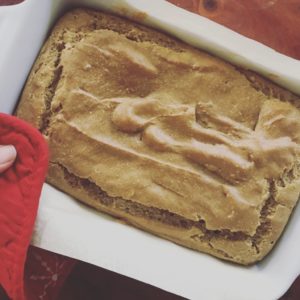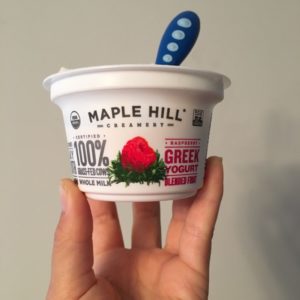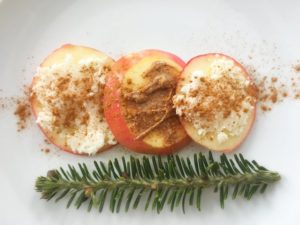The advice we receive about healthy food for kids rarely mentions food source, quality, and nutrient density. A quick google search for “healthy kid snacks” leads you to lists of processed cheese, sugar, and baked foods with refined vegetable oils, flours, and more sugar. One list even included whoopie pies. I nearly had a seizure.
Feeding kids is hard. I’ve got one of ‘em, so I know this to be true. Here are some healthy kid snacks we eat and love in my house. These are all real food, nutrient-dense snacks that will build up those little bodies.
Check out my original post, 5 (Truly) Healthy Snacks for Kids, Part 1 for even more ideas, and to find out what I think about the USDA’s recommendations for child nutrition.
Healthy baked goods
Baking recipes on the internet leave a lot to be desired. My secret? I use the word “paleo” when searching for cookies, muffins, breads, etc. Paleo baked goods leave out the refined, nutrient-poor flours, sugars, and inflammatory oils. They typically include a fair amount of eggs which are an amazing food for your little one. You know that advice from nutritionists everywhere to take a multivitamin for “insurance”? Well, I don’t love most kid multis, so I say: eat a few eggs a day instead (especially the yolks.)
Eggs from pasture-raised chickens are packed with nutrition. Egg yolks alone contain fat soluble vitamins A, D, E, K2, B vitamins, essential fatty acids, choline, biotin, iron, zinc…are you impressed yet? I will stress the importance of pasture-raised part here; how chickens are raised and what they are fed makes a BIG difference in the nutrition of their eggs. This banana bread is full of bananas, eggs and healthy fats. It’s our favorite!
I also love to add veggies to the mix when baking. Here are a few recipes that do just that:

Organic, full-fat, grass-fed yogurt
Yogurt is a snacking staple in most households. By selecting an organic product, you’ll ensure your child is avoiding growth hormones and antibiotics. Full-fat and grass-fed labels back up the nutrient content of the yogurt. When a cow is allowed to eat grass (instead of grain, corn, and soy), the milk becomes far more nutritious with naturally occurring vitamins A, D, E, K2, and essentially fatty acids. When we remove the fat (like in skim or low fat dairy), we remove those nutrients. Sad face.
Fortunately, grass-fed yogurt is getting easier to find. Brookford Farm does a lot of grass-fed dairy and are sold in local Seacoast markets. Maple Hill Creamery, Organic Valley Grassmilk, Stonyfield organic grass-fed yogurt, and Trader Joe’s brand are other options. Always look for “100% grass fed” on the label.
Goat and sheep yogurt are also healthy options as they contain a different type of protein than conventional cow dairy. These proteins are more compatible with human digestion, making it gentler on little tummies.
I typically buy plain yogurt, then sweeten with local maple syrup or honey. I also stir in roasted sweet potatoes or canned pumpkin to add fiber and additional antioxidants and phytonutrients.

Ants on a Log
Not exactly revolutionary, I know. Heck, you and I were eating celery smothered in peanut butter and raisins back in the day. But let’s try a few new twists on an old favorite.
Use organic celery.
Celery makes the EWG’s Dirty Dozen (a list of produce highest in pesticides) every year, so always buy organic.
Use organic raisins – or try other dried fruit!
Grapes – and therefore raisins – are also always on the Dirty Dozen list, so grab the organic option. Always check the ingredient list to be sure the raisins aren’t covered in oil – safflower or sunflower oil is often added to keep dried fruit from sticking together. The organic Thompson seedless raisins at Trader Joe’s don’t list any oil.
You can also use other dried fruit, like chopped dates, cherries, cranberries, apples, etc. Be sure these are unsweetened (or only sweetened with apple juice in the case of cranberries.)
Try some other spreads.
I’m not completely against peanut butter, but it has some issues (I smell a spin off blog coming your way.) I buy organic, natural peanut butter for my daughter (where the only ingredients are organic peanuts and salt), but I always rotate it out with other spreads like almond, cashew, sunflower, and coconut butters.
Tahini is actually our favorite for ants on a log, so that’s what I use in place of PB. Add a sprinkle of cinnamon, and maybe a dollop of honey and you’re golden.
Speaking of coconut butter…
If you’ve got a food processor, you can make your own coconut butter. It’s cheap, and it’s oh-so-good. Coconut butter provides fiber and fat. The type of fat it containts (medium chain triglycerides) are unique in that they don’t need pancreatic enzymes to be digested, making them available for immediate energy. Despite what you might have heard, coconut is a healthy source of fat for your kiddos. Whether it’s homemade or store bought, here are our favorite ways to eat coconut butter:
- Straight up out of the jar with a spoon
- In a smoothie
- Spread on toast, sweet potato “toast”, or baked goods
- Stir into a bowl of oatmeal
- Spread on fruit slices
- Mash into a roasted sweet potato with some cinnamon (I love using Japanese sweet potatoes for this because they’re so sweet!)
- Crumble over baked apples
- My favorite way: heat up frozen blueberries until slightly warmed and juicy. Sprinkle with cinnamon. Crumble coconut butter on top and give a good stir so it get all melty.
Check out the recipe for Homemade Cake Batter Coconut Butter here.

Want to hear more about healthy snacking? Check out Episode 2 of the Funk’tional Nutrition Podcast. We’re chatting all about snacks!










